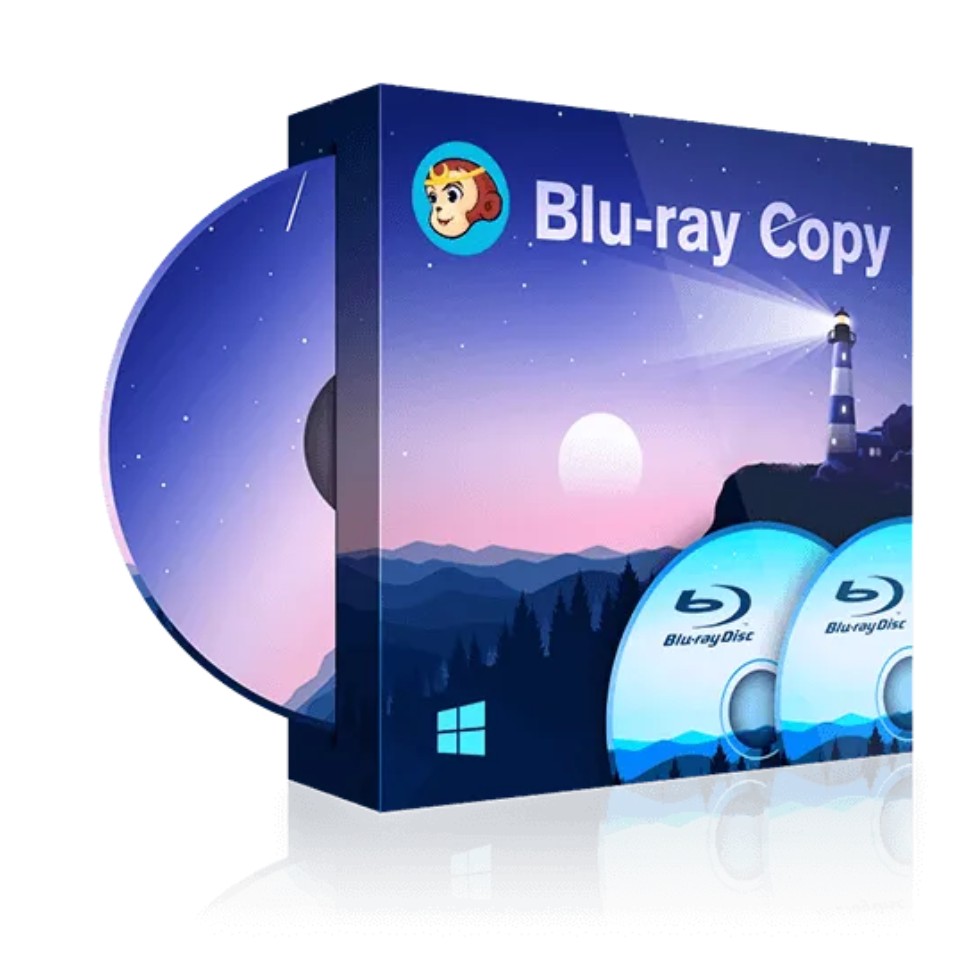What Is Blu-ray? Definition, Resolution, Region Codes, and Playback
Summary: Blu-ray is the third generation of optical disc formats, following audio CDs and DVDs. In this comprehensive guide, you'll learn the definition of Blu-ray, what its features are, the key differences between Blu-ray, DVD, and 4K, as well as how to handle Blu-ray region codes for hassle-free playback.
Table of Contents

Blu-ray discs have become known for delivering true high-definition (HD) home entertainment, yet many still question what sets Blu-ray apart from DVDs or 4K streaming. In this article, you'll discover the ultimate answer to "what is Blu-ray." We'll also illustrate features of Blu-ray and key differences between Blu-ray, DVD, and 4K Ultra HD.
What is Blu-ray
Blu-ray Disc, often shortened to Blu-ray or BD, is a type of optical disc made for high-definition video and data storage. Unlike standard DVDs which use a red laser, Blu-ray uses a blue-violet laser with a shorter wavelength. This allows Blu-ray discs to store significantly more data, with a single layer holding up to 25GB compared to a standard DVD's 4.7GB capacity. This increased storage capacity, along with advanced video and audio codecs, provides a superior HD experience.
The Blu-ray format was created by the Blu-ray Disc Association, a coalition of major tech and media companies, to address the rising demand for clearer and more detailed home video. Although it officially launched in 2006, its development is rooted in earlier optical storage advances. Blu-ray quickly became favored for Hollywood films, gaming, and professional data archiving. Today, it supports everything from standard films to 3D and ultra-high-definition (UHD) content, making it a versatile option for those seeking excellent visual and audio quality.

- A Blu-ray disc can store more data than a DVD because it uses a blue-violet laser with a much shorter wavelength of 405 nm, compared to the 650 nm red laser used in DVDs. The shorter wavelength allows the laser to focus on smaller spots, enabling it to read and write finer data pits on the disc. This greatly increases the data density on a disc.
Key Features of Blu-ray
Blu-ray discs are advanced and high in quality because of their inherent characteristics. Below we will explain the features of BD in detail, especially resolution, as well as audio and video quality.
Resolution
One of Blu-ray's key features is its support for HD video. A standard Blu-ray disc delivers Full HD 1080p resolution (1920×1080 pixels). Ultra HD Blu-ray, a more advanced version, supports 4K UHD resolution (3840×2160 pixels) and adds better color depth with High Dynamic Range (HDR). This improvement in clarity offers richer details, more vivid colors, and a more engaging viewing experience, especially on larger screens.
Blu-ray technology supports several disc types, each serving a unique purpose:
- BD-ROM (Blu-ray Disc Read-Only Memory): These are the pre-recorded Blu-rays you buy in stores, such as movies, TV shows, or game Blu-rays. Content is permanently burned in at the factory, and the disc cannot be written or erased by consumers.
- BD-R (Blu-ray Disc Recordable): These recordable discs let users burn data or video onto them once, similar to a DVD-R. Once the data is written, it cannot be erased or overwritten.
- BD-RE (Blu-ray Disc Rewritable): BD-RE discs offer the flexibility to write, erase, and re-record data multiple times, much like a DVD-RW.
| Blu-ray Type | Recordable? | Rewritable? | Typical Use |
| BD-ROM | No | No | Commercial movies, games, pre-recorded content |
| BD-R | Yes | No | Data backup, home video recording |
| BD-RE | Yes | Yes | Frequent data changes, test recordings |
In addition to these, there are specialized formats that tailor to specific needs:
- BDXL: These high-capacity discs can hold 100GB (triple-layer) or even 128GB (quad-layer), often used for professional data backup or archival needs.
- 3D Blu-ray: Enables playback of stereoscopic 3D video content, provided you have the compatible player and display.
- 4K Ultra HD Blu-ray: The premium format for movies, supporting 4K resolution and advanced features like HDR and wider color gamuts; requires a compatible player and display.
Storage Capacity
A key factor behind Blu-ray's storage advantage is its use of multiple data layers. Each layer increases the disc's total capacity, enabling it to store more high-resolution video or data without changing the disc's physical size. Here's a quick look at how layering works across different Blu-ray disc types:
| Layers | Capacity per Blu-ray Disc | Disc Type |
| Single Layer | 25 GB |
BD-ROM, BD-R, BD-RE |
| Dual Layer | 50 GB | |
| Triple Layer | 100 GB | BDXL |
| Quad Layer | 128 GB |
Standard Blu-ray discs (BD-ROM, BD-R, BD-RE) hold up to 25GB on a single layer, while dual-layer versions can store up to 50GB. This is sufficient for hours of high-bitrate HD video or extensive game data. BDXL discs, with their triple- and quad-layer designs, are ideal for professionals or users needing large storage capacity, such as for native 4K content, substantial data backups, or extensive video archives.

- When it comes to storing BDs of various capacities, all Blu-ray discs are the same physical size, regardless of the number of layers or storage size. Therefore, standard Blu-ray cases are suitable for storing any of them. If you're concerned about damage caused by improper storage, you can look up guides on how to rip Blu-ray discs to convert them into digital files and store them on your hard drive for backup.
What is the Difference Between Blu-ray, DVD and 4K UHD?
With all the talk about Blu-ray, many people wonder how it truly compares to DVD, or even to the newer 4K Ultra HD Blu-ray format. Let's break down the differences to see what sets each one apart.
📀DVD remains the standard for standard-definition video, offering a resolution of 480p (720x480 pixels for NTSC, 720x576 for PAL) and stores up to 4.7GB on a single layer. The audio features are basic, and the format isn't suited for HD displays.
💿Blu-ray made the shift to Full HD 1080p (1920x1080 pixels) with storage capabilities reaching 25GB for single-layer discs and 50GB for dual-layer discs. Thanks to advanced codecs and higher bitrates, Blu-ray delivers much sharper video and richer audio quality.
💿4K Ultra HD Blu-ray (4K UHD Blu-ray) further elevates quality, supporting true 4K resolution (3840x2160 pixels), High Dynamic Range (HDR), broader color gamuts, and advanced audio formats. These discs can store up to 100GB, accommodating ultra-high bitrate movies and additional content.
| DVD vs Blu-ray vs 4K | |||
| Feature | DVD | Blu-ray | 4K UHD Blu-ray |
| Max Resolution | 720 × 480 (480p SD) | 1920 × 1080 (1080p Full HD) | 3840 × 2160 (2160p 4K UHD) |
| Color Gamut | BT.601 | BT.709 | BT.2020 |
| Dynamic Range | Standard Dynamic Range (SDR) | ~100 nit | 1,000 - 10,000 nit (HDR) |
| Bit Depth | 8-bit | 8-bit | 10-bit |
| Peak Video Bitrate | ~11.08 Mbps | 40 Mbps | 100 Mbps |
| Max Capacity per Disc | 4.7GB (single layer) | 25GB (single) / 50GB (dual) | 66GB (dual) / 100GB (triple) |
| Audio Capability | Dolby Digital, basic PCM | Dolby TrueHD, DTS-HD MA | Dolby Atmos, DTS:X |
In essence, each format builds upon the last: DVD offers basic video; Blu-ray upgrades to genuine HD; and 4K Ultra HD Blu-ray pushes into ultra-crisp, theater-quality territory for enthusiasts seeking the advanced home viewing experience.
How to Play Blu-rays
How to actually watch a Blu-ray disc or wondering what kind of device you need? Whether you can play Blu-rays from other regions? Want to know does Xbox 360 Play Blu-ray? Let's explore the main options for enjoying Blu-ray movies at home.
Region Codes
Region Codes are restrictions set by studios and manufacturers to control where a Blu-ray disc can be played. There are three Blu-ray region codes: A, B, and C, covering different regions (see the table below). But not every Blu-ray disc actually has region coding, some of Blu-rays are marked "region free." You can usually find the region information right on the disc packaging or printed directly on the disc itself. If a disc is coded for one region, it won't play on a player from another region unless your player is region-free (more on that later). Always check both your player and disc labels for compatibility; this small detail can make or break your movie night.
| Region Code | Covered Areas |
| Region A | Americas (North, Central & South America), East Asia (Japan, Korea, etc), Southeast Asia |
| Region B | Europe, Africa, Middle East, Australia, New Zealand, and their dependencies |
| Region C | China, India, Russia, Central Asia, Mongolia, South Asia, Belarus, Ukraine, Kazakhstan, Moldova, and nearby regions |
Blu-ray Player [Hardware]
To enjoy Blu-ray's benefits, you need compatible hardware such as a Blu-ray player. A traditional Blu-ray player is specifically designed to read Blu-ray discs. These players come in standalone models, including both cost-effective and premium options with advanced audio features. The recommended Blu-ray players include the Panasonic DP-UB9000, Sony UBP-X800M2, and LG UBK90.

If you have a DVD player, you're probably wondering: Can you play Blu-ray on DVD player? Unluckily, you can't. While Blu-ray players are backward compatible with DVDs and CDs, the reverse is not true—standard DVD players cannot play Blu-ray discs due to the different laser technology and higher data density.
The fact that a DVD player cannot play Blu-ray discs has become one of the main reasons why many people hesitate to buy a Blu-ray player. People start to wonder how long Blu-ray discs will last, especially when faced with the possibility that, just like DVD players, Blu-ray players might eventually become obsolete. In such a case, using software for playback is your best alternative.

- For gaming enthusiasts, you might wonder whether your game console can play Blu-ray discs. Nintendo users may wonder: does Wii play Blu-ray? Unfortunately, not all game consoles support Blu-ray playback. Currently, the consoles that do include the Xbox One, and Xbox Series X/S. Earlier consoles like the Wii do not have Blu-ray capability.
Blu-ray Player [Software]
What is a streaming Blu-ray player? A streaming Blu-ray player such as PlayerFab is a device that not only plays Blu-ray, DVD, and CD discs, but also connects to the internet to access streaming services like Netflix, Hulu, or Amazon Prime Video. These "smart" players combine region-free physical playback with modern streaming convenience. However, keep in mind that to play Blu-ray discs with any software, you must have a Blu-ray drive. This can be either built into your computer or connected as an external device.
How to Back up Blu-ray Discs?
For many disc collectors, backing up or copying discs is routine. This is definitely a win-win method: making a 1:1 backup of your Blu-ray disc to your hard drive or cloning it onto another disc protects your collection from scratches or loss and allows you to play your disc image files on your computer anytime, anywhere, without having to worry about Wi-Fi or internet speed.
Specialized software tools like DVDFab Blu-ray Copy enable you to back up your Blu-ray discs, even those with copy protection or region codes, either to another blank disc or as an ISO or folder on your computer. This software supports lossless backup for BD-50 and BD-25, cloning the original video and HD audio streams in 1:1 quality. It can also compress any BD-50 Blu-ray to a standard BD-25 to save storage space, easily meeting your various backup needs.
Frequently Asked Questions
The United States is part of Region A when it comes to Blu-ray discs. This means that most Blu-ray discs bought in the US are encoded for Region A, which also includes Canada, Japan, South Korea, and parts of Southeast Asia.
A multi-format Blu-ray typically refers to a set that contains the main movie on Blu-ray along with additional formats, like a DVD and a digital copy. This gives you more flexibility. You can watch the movie in HD at home and use DVD or digital versions on other devices.
The difference of HD DVD vs Blu-ray is that Blu-ray discs could store more data and gained stronger support from studios and manufacturers. As a result, Blu-ray won the "format war" and HD DVD is now discontinued.
4K Ultra HD Blu-ray offers much higher bitrates and less compression compared to 4K streaming services. This results in better picture detail, richer colors, and more consistent performance, which is particularly noticeable during fast-moving scenes or when viewed on large-screen TVs.
It's true that many gaming and movie enthusiasts ask "Does PS3 play Blu-ray" on forums. The answer is yes. Sony's PlayStation 3 was the first major console to offer full Blu-ray support, and both the PlayStation 4 and PlayStation 5 continue this tradition.
Conclusion
After reading this blog, you must know the answer to "what is Blu-ray". Despite the rise of streaming, Blu-ray is still favored by collectors and those who seek excellent high-resolution viewing. With the right player or dependable backup software, your Blu-ray library can offer a cinematic experience while safeguarding your discs from wear.




